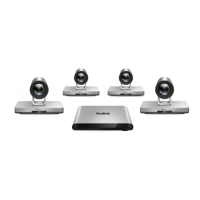| Configuring the Audio Settings | 130
as the audio output, or you switch to a different HDMI as the device output and you connect an audio
input device (the VP59/VC200 has built-in microphone without audio input), the system automatically
enters the EQ self adaption adjustment.
You can also manually trigger the system to enter the EQ self adaption adjustment in the idle state.
For VC880/VC800/VC500/PVT980/PVT950:
• When the audio output switches to HDMI or Line Output/USB Line output and you connect an audio
input device, click Start EQ Self Adaption to optimize the acoustic effect.
For VP59/VC200:
• When the audio output switches to HDMI or Line Output/USB Line output, click Start EQ Self
Adaption to optimize the acoustic effect.
• After the factory reset, connect the display device for the first time.
• Configuring the EQ Self-adaption
Configuring the EQ Self-adaption
Procedure
1. On your web user interface, go to Setting > Video & Audio > Audio Settings.
2. Configure and save the following settings:
Parameter Description Configuration Method
EQ Self-Adaption
Enable or disable the EQ self-
adaption feature on the system.
Default: On.
Web user interface
Start EQ Self Adaption
Starts the EQ self-adaption
feature.
Note: This configuration appears
only when the system satisfies
the following conditions:
• Enable the EQ Self Adaption
feature.
• The VCS phone is not
selected as the audio output
device.
• Connect an audio input
to the device (it is only
applicable to VC880/VC800/
VC500/PVT980/PVT950)
• The audio output is HDMI or
Line Output/USB Line out.
Web user interface
Configuring the Noise Suppression
The noises in the room may be picked-up, including paper rustling, coffee mugs, coughing, typing and
silverware striking plates. These noises, when transmitted to remote participants, can be very distracting.
You can enable the Transient Noise Suppressor (TNS) to suppress these noises. You can also enable the
Noise Barrier feature to block these noises when there is no speech in a call.

